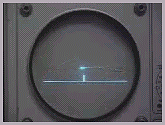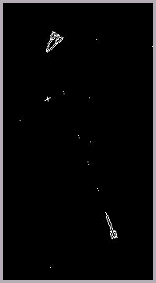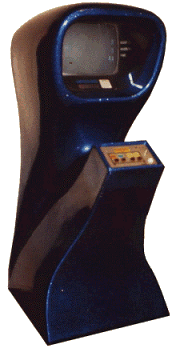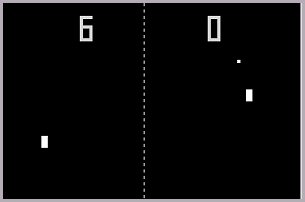The first two games to appear on the home video game market were “Pong” and
“Asteroids”. Albeit under different monikers.
These games are direct ancestors of the games like Mario Tennis and STAR WARS:
Starfighter, and paved the way for titles like Grand Theft Auto 3 and Devil
May Cry. They also have a nostalgia value for people of a certain age. It was
our entry into the world of the future, where, we believed, everyone would wear
silver and dance to disco. Nowadays, kids are introduced to gaming by products
where you can barely tell it’s not a film, but we people of a certain age know of the pleasure that
can be gained from hitting a little white dot around a screen. All we needed
to while away a whole afternoon was a black & white TV, a brown box and,
if you were lucky, a pistol made out of some bakelite-like material.
In fact, the origins of home gaming have their feet in an incredibly early
time: [interesting fact number 1] the company that was to become Nintendo was
founded in 1889 to manufacture Japanese playing cards.
But we’ll skip a few decades to discover the real origins of home computer
games, as we go back deep into the mists of time… a time when Bill Gates was
barely past being a twinkle in his daddy’s eye, but Joan Rivers still looked
like a skull on a mop handle.
Play Oilzine's Free Online Games Here
Magnavox Odyssey (Pong) - Ralph Baer, Bill Harrison and Bill Rusch - Sanders
Associates
 The
first version of a video game had a peculiar origin, and an unlikely creator.
In 1958 Willy Higinbotham, a physicist, designed a simple tennis like game for
his oscilloscope. He wanted to keep members of the public entertained during
open days at the Brookhaven National Laboratories. As it happened, it was a
great success, with people queuing for hours to play the simple game. The main
difference from what is now the classic game of Pong was that this was a side
on view of a game of tennis. There was a horizontal line representing the ground
and the players and the ‘ball’ was under the effects of gravity always being
drawn towards the ground. Future variations included an option to control the
gravitational pull, so simulating a game of tennis on, for example, the moon,
or another planet. Another control that is variant from classic Pong was that
players could put ‘spin’ on the ‘ball’ to help it go over the net.
The
first version of a video game had a peculiar origin, and an unlikely creator.
In 1958 Willy Higinbotham, a physicist, designed a simple tennis like game for
his oscilloscope. He wanted to keep members of the public entertained during
open days at the Brookhaven National Laboratories. As it happened, it was a
great success, with people queuing for hours to play the simple game. The main
difference from what is now the classic game of Pong was that this was a side
on view of a game of tennis. There was a horizontal line representing the ground
and the players and the ‘ball’ was under the effects of gravity always being
drawn towards the ground. Future variations included an option to control the
gravitational pull, so simulating a game of tennis on, for example, the moon,
or another planet. Another control that is variant from classic Pong was that
players could put ‘spin’ on the ‘ball’ to help it go over the net.
"Pong" also had its origins (some would say its main origins) in a game developed
by Ralph Baer. Baer was working as the manager of equipment design at a military
electronics company called Sanders Associates. Some years earlier (1951), whilst
working for military electronics firm Loral (he liked military electronics, then), the seeds of invention had been
planted in Baer’s mind, when he was asked to build a TV set to beat all TV sets.
Baer decided that the public’s relationship with TV sets was too passive, and
thought that to build the best TV in the world he needed to make the whole thing
interactive. He suggested a built in game to entertain the minds of the ‘punters’.
This suggestion was met with scepticism by his bosses at Loral and they rejected
the idea out of hand. The vision just wouldn’t go away, however.
Sometime in the summer of 1966, Baer was waiting for a colleague to turn up
for a meeting. He was late. So in the meantime Baer took the opportunity to
jot down a few ideas for the secondary uses of TV sets. With help from Bob Tremblay
and Bob Solomon, colleagues at Sanders, he developed a rudimentary version of
his idea. After showing this proposal to one of his superiors, Herbert Campman,
Director of Research and Development at Sanders, decided it was worth pursuing
and gave him the time, and more importantly, the manpower to develop his brainwave
fully.
Bill Harrison and Bill Rusch were detailed to help Baer in the development
of an interactive game, and in 1967 their hard work came to fruition when they
produced their first game. This basic game was based on one dot chasing another
around the screen trying to make it disappear, rather like tag. Soon, however,
they followed it up with a video tennis game (which would to develop into the
Magnavox Odyssey and "Pong"). At this time, they also happened to invent the classic
symbol of 70s home gaming when they modified a toy gun so that it could differentiate
between spots of light on the TV screen.
Probably the most important thing that Baer did in this period was not to invent
the game, though. In 1968, he filed for and won the first patent for a video
game version of ping-pong. This would come to be his greatest move, as companies
jumping on the ping-pong bandwagon had to pay out licensing fees to produce
their versions of the game. But more about this later.
By late 1968, Baer and colleagues had developed the original idea of an interactive
video game into a fully functioning “Brown Box”, a machine that was capable
of playing ping-pong, (American) football, volleyball, and various games involving
the gun. Sanders Associates was, nevertheless, a military electronics company,
and couldn’t really diversify into the ‘toy’ market, so the decision was made
to license the game to another manufacturer.
After demonstrating the “Brown Box” to various TV-set manufacturers, they were
met with interest, but no firm enquiries. This was until Magnavox stepped into
the breech and took a gamble on the unit.
 In
1972, the “Magnavox Odyssey” was launched. Baer was particularly pleased as,
despite Magnavox’s own development upon his original, it was a dead-ringer for
his “Brown Box”. Little did he realise that trouble was only around the corner…
In
1972, the “Magnavox Odyssey” was launched. Baer was particularly pleased as,
despite Magnavox’s own development upon his original, it was a dead-ringer for
his “Brown Box”. Little did he realise that trouble was only around the corner…
When he initially had his brainwave in 1966, Baer had envisioned his machine
being an add-on costing around $20. The “Magnavox Odyssey” was priced at $100.
This coupled with the public misconception that the game would only work on
one of Magnavox’s TV sets, meant that the “Odyssey” was rather less successful
than it should have been.
Still the video game industry had been launched, as had one of the most endearing
titles ever to hit the screen.
Play Oilzine's Free Online Games Here
Space War (Asteroids) - Steve Russell – MIT - Tech Model Railroad Club (TMRC)
- PDP-1
In 1961, the game that would eventually become Asteroids started life, humbly,
at MIT (Massachusetts Institute of Technology).
The MIT had recently obtained a new system based upon a DEC PDP-1 mainframe
computer, a machine which was relatively minute (only the size of a large car).
This piece of equipment was soon interesting members of the drippy “Tech Model
Railroad Club”, a club devoted to the typical ‘beat-me-up-I’ve-got-glasses’
subjects such as sci-fi novels and computer programming. The club was the refuge
of students who enjoyed coding systems, and they programmed for pleasure, rather
than any monetary gain. It was also open source, so the code was public domain,
available for anybody to utilize and improve upon.
The TMRC, thankfully, quickly started developing programs to run on this ‘powerful’
new machine (their game eventually weighed in at a massive 9k).
Amongst this group of nerds was a guy nicknamed “Slug”, Steve Russell. Although
he is often credited with single-handedly developing the first ‘space’ game,
it was actually more of a team effort, albeit with Russell as main programmer.
Features that were created by other members of the TMRC were a realistic star
field background, accurate gravity effects, and the (now) ubiquitous hyperspace
facility.
 The
game they developed was named “Space War”, and was based upon the concept of
two spaceships pitted against each other in a missile duel.
The
game they developed was named “Space War”, and was based upon the concept of
two spaceships pitted against each other in a missile duel.
It had its limitations, as was to be expected in 1961. The main ones being
that the ‘graphics’ were made up of text characters, and people needed a device
the size of Pavarotti to play the game.
Despite these restrictions, it was a massive success with the computer community,
and copies of the game were soon spreading around campuses faster than herpes.
It is even said that potential customers were shown the program by Digital
Equipment Corporation (the manufacturers of the system) to demonstrate the potential
of its PDP-1 and that DEC included it with every installed system. Sounds familiar…
Monopoly Commission anyone?
Unfortunately for Russell, like Willy Higinbotham, he didn’t patent his work.
This is possibly because he was too busy reading comics and squeezing spots,
or more probably because the system that “Spacewar” ran on was physically massive
and economically even bigger (it cost around US$120,000). This meant that the
initial program that went on to be copied and eventually sold for millions didn’t
net its author anything. Apart from a bit of fame, maybe.
[Interesting fact number 2] “Spacewar” was also responsible for the development
of the computer ‘joystick’, as two enthusiasts created the first joystick devices
to replace the clumsy control switches.
Play Oilzine's Free Online Games Here
Pong – Computer Space – Nolan Bushnell – Nutting Associates - Atari
Both games, however, owe their success to one peculiarly named man, Nolan Bushnell.
Bushnell was an engineering student at the University of Utah, which is where
he was first exposed to Steve Russell's DEC PDP-1 game “Spacewar”. He was quickly
addicted, spending most of his time playing it, rather than studying. You're kidding me... a student not working?
In 1965, Bushnell did what most students have to do, and found work for the
summer holidays. By good fortune, he ended up working in an arcade (which at
that time basically existed on pinball and slot machines), and it was this exposure
that convinced him of the marketability of video games and “Spacewar” in particular.
By 1970 Bushnell had enlisted Ted Dabney and together they worked on an arcade
version of “Spacewar” in the bedroom of Bushnell’s daughter (she was moved into
her sister’s room for the duration). Bushnell called the game “Computer Space”.
 “Computer
Space” was soon picked up by Nutting Associates and in 1971, they began manufacturing
what would become the precursor for “Asteroids” – “Computer Space”.
“Computer
Space” was soon picked up by Nutting Associates and in 1971, they began manufacturing
what would become the precursor for “Asteroids” – “Computer Space”.
Unfortunately for Nutting, “Computer Space”, the first video arcade game, was
a flop [“Asteroids” was first released by Atari in 1979]. Bushnell, believing
that the public found it too hard to play, informed Nutting that they need a
much simpler game in order to capture the public’s imagination. Now came the
problem...
Nutting Associates agreed with Bushnell that a new, much less complicated,
game should be developed and agreed to fund it, the problem was, though, that
Bushnell wanted more money. He left, and so stopped Nutting becoming a truly
internationally famous name and symbol of a whole generation’s youth, as we
shall see.
When Bushnell left, he formed a new company with old friend Ted Dabney (who,
you remember helped him create “Computer Space”), using an initial capital investment
of $250. The company they founded was named Atari (a Japanese word from the
game “Go”, meaning the equivalent of ‘Check’ in chess). Thankfully, their original
choice, Syzygy (the straight-line configuration of three celestial bodies),
had already been taken by a roofing firm. The plan with their new company was
to design and develop video games but not to build the machines, with other
companies manufacturing and distributing the finished games.
The real story of “Pong” now begins, almost by accident.
I mentioned that Bushnell was looking to develop a simple game with which to
reel in joe public. Pong was, however, not meant to be that game. Bushnell and
Dabney hired a programmer called Al Alcorn, and since he was rather inexperienced,
Bushnell gave him the task of programming an uncomplicated tennis game so he
could get into the job. The result was, you’ve guessed it, “Pong”. Named so
because of it was the sound that the ‘ball’ made when hitting the ‘paddles’
and because “Ping-Pong” was already subject to copyright.
Alas, although their plan was to sell their games to manufacturers, none were
particularly interested in this new video tennis game. The fools. Nevertheless,
convinced of its marketability, Bushnell pushes on with constructing and marketing
the game himself at Atari.
 And
so Atari’s “Pong” made its debut at a local bar in 1972.
And
so Atari’s “Pong” made its debut at a local bar in 1972.
Bushnell’s first inkling that “Pong” might be a success came very soon after
its debut in the bar. He was called back to fix the machine, as it had broken
down. He soon discovered that it had packed up because it was full to the brim
of money.
Atari “Pong” was a rip-roaring success from then onwards.
The problem with deciding the definite origins of the game of “Pong” is that
although everyone recognises the fact that Higinbotham created the first version
of a tennis-like game, he didn’t patent the idea, assuming that it was such
a simple and obvious idea, it wasn’t worth pursuing.
Baer, however, could see the value in the burgeoning video game market and
patented his creation. This is not to say that Baer deliberately exploited Higinbotham,
in fact Baer didn’t learn of Higinbotham’s version until many years after acquiring
the patent.
Baer’s creation was displayed by Magnavox at a convention in 1972, and the
young Nolan Bushnell was sent by Nutting Associates to check out the competition.
He played the various games that the “Odyssey” had to offer, but concluded that
it was uninteresting and not realistic competition to “Computer Space”. It would
come back to haunt him….
Bushnell was correct that the Magnavox “Odyssey” wasn’t competition for “Computer
Space”, but his exposure to the “Odyssey” at this fair later became the crux
of a patent infringement lawsuit filed by Magnavox over his later foray into
arcade videogames, “Pong”.
Images courtesy of The Dot Eaters - http://www.emuunlim.com/doteaters/
Play Oilzine's Free Online Games Here
Post Script:
Willy Higinbotham died in 1995, at the age of 84.
Steve Russell appears to have got a proper job and apparently manages programmers
in Silicon Valley. I assume he’s still alive.
Ralph Baer went on to be a successful inventor and developer, inventing the
electronic game “Simon” along the way. Still very much alive.
Nolan Bushnell sold Atari to Warner Communications for $28 million in 1976.
Again still alive and active.
Links:
www.osti.gov/accomplishments/videogame.html
- 1958 Brookhaven Laboratories (Fantastic clip of "Tennis for Two")
http://www.emuunlim.com/doteaters/
- The Dot Eaters - classic video game history
http://www.pong-story.com/eaus0576.htm
- PONG: Make-It-Yourself projects - Electronics Australia, may 1976
http://www.pong-story.com/
- Site devoted to “Pong”
http://www.enteract.com/~enf/lore/spacewar/spacewar.html
- Origin of “Spacewar”
http://www.ralphbaer.com/
- Ralph Baer’s own website
http://www.thetech.org/revolutionaries/bushnell/i_a.html
- Interview with Nolan Bushnell